The Yueming Li Lab
Research Interests
Basic & Translational research in Cancer and Alzheimer’s disease:
From disease mechanism to therapeutic development.
Research Areas
Target Identification & Drug Discovery
Chemical Biology & Medicinal Chemistry
Biochemistry & Enzymology
Biophysics & Structural Biology
Animal models & Behavior
Neurobiology & Neuroinflammation
Autophagy, Protein Aggregation & Clearance
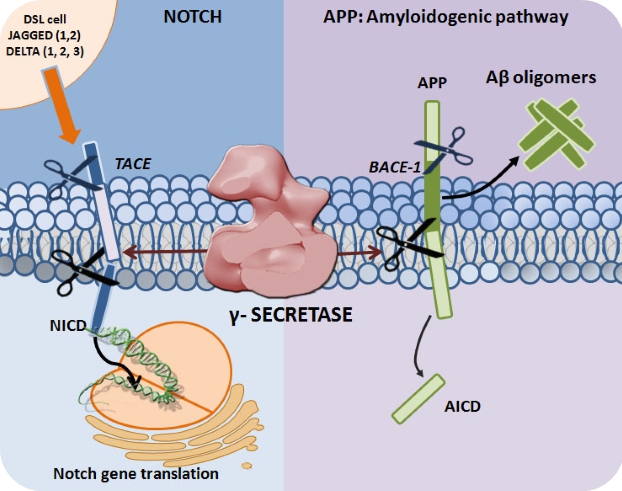
Proteolytic processing of APP and Notch
Mature Notch receptors are activated by binding to ligands (Jagged-1, -2 and Delta-like -1, -3, and -4) located on adjacent signal-presenting cells. An induced conformational change exposes a cleavage site (S2) for ADAM family metalloproteases that cleave Notch at an extracellular, membrane-proximal region. The membrane-bound Notch segment that results from this cleavage, known as Notch Intracellular Truncation domain (NEXT), is a γ-secretase substrate. γ-Secretase performs the subsequent cleavage at S3 releasing Notch intracellular domain (NICD) from the membrane and allowing for signal transduction through binding with the CBL-1, Su(H), Lag-1 family of DNA binding proteins. APP undergoes sequential proteolytic processing first by β-secretase (BACE1, aspartyl protease) and then by γ-secretase, in the amyloidogenic pathway. The first cleavage results in ectodomain shedding in which the amino-terminal of APP is removed, yielding a soluble APP derivative (sAPPβ) and a carboxy-terminal membrane stub known as βCTF (C99). βCTF is a substrate for γ-secretase, and is cleaved in its transmembrane domain to form AICD and the potentially toxic Aβ. Mutations in presenilin (the catalytic subunit of γ-secretase) and APP can lead to increases in the Aβ42 to Aβ40 ratio, resulting in Aβ deposition and plaque formation.
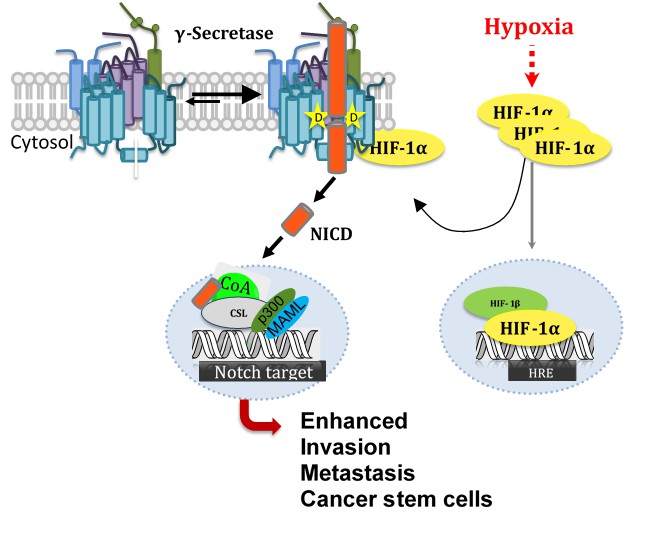
Non-transcriptional Role of HIF-1α
HIF-1α is often thought to be only a context-dependent transcription factor. However, our lab has uncovered a new non-transcriptional role of HIF-1α interacting with and activating γ-secretase. This interaction between HIF-1α and γ-secretase has been shown by our lab to increase Notch signaling in breast cancer. An increase in Notch signaling has been shown to exacerbate cancer progression by increasing invasion, migration, metastasis and an increase in cancer stem cells. We are currently further interrogating this non-transcription role of HIF-1α in its activation of γ-secretase and subsequent Notch signaling using cell and mouse models.
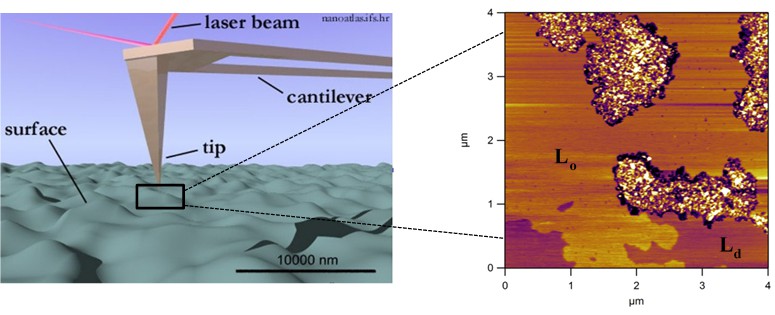
Partitioning of γ-secretase and its substrates in lipid microdomains as probed by AFM
Despite substantial advances in elucidating how the γ-secretase complex functions, the effect of the local membrane lipid microenvironment on γ-secretase spatial distribution and cleavage of substrates is still poorly understood. We aim to characterize the partitioning of γ-secretase and its substrates, Notch and APP, using solid supported membranes of various lipid compositions. With atomic force microscopy (AFM) we are able to reveal membrane heterogeneities, ordered (lo) and disordered (ld) domains, and determine how the localization and clustering of γ-secretase and its substrates are influenced by the membrane lateral organization.
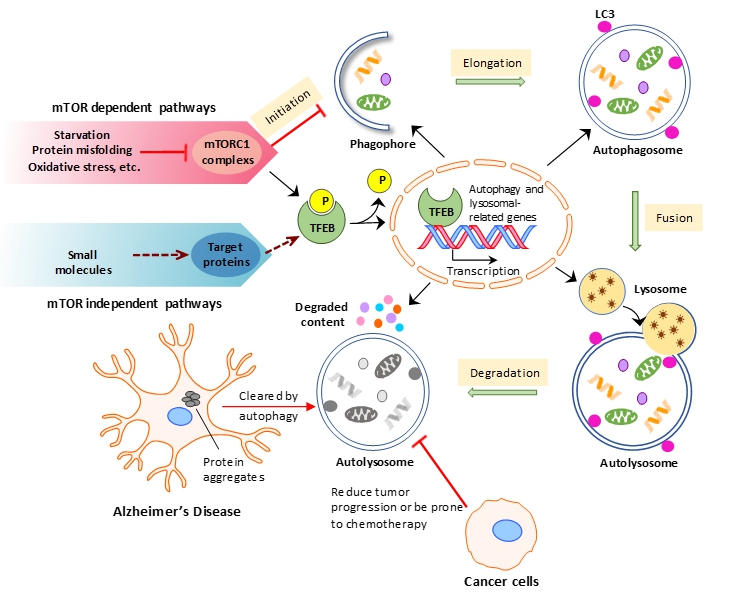
Autophagic modulators as a therapy for Alzheimer’s disease and Cancer
Autophagy, a highly regulated pathway, is entered by cells under various conditions including starvation, protein misfolding and oxidative stress. In the autophagic pathway, initiation begins by the formation of a pre-autophagosomal structure (PAS), followed by subsequent elongation of the membrane by leading edges of the phagophore, and finally, fusion of these edges to generate a fully formed autophagosome. Lysosomes then fuse to autophagosomes, helping to degrade the engulfed contents and release them into the cytoplasm. This process allows cells to eliminate injurious components, and ultimately to survive. Transcription factor EB (TFEB) has been shown to be the master regulatory of the autophagic-lysosomal pathway. Under normal conditions TFEB is phosphorylated by mTORC1 and remains in the cytoplasm. Inactivation of mTORC1 in this pathway thus leads to translocation of TFEB into the nucleus, where it initiates autophagic and lysosomal-related gene expression. Due to increasing reports implicating autophagy in the clearance of Tau aggregates in Alzheimer’s disease and in the promotion of tumor progression in various types of cancer, as well as in studies demonstrating the downsides of long-term mTOR, our lab investigates small molecules as autophagic inducers to promote autophagic flux through mTOR independent pathways. Eventually, our hope is to use autophagic modulators as therapeutic drug treatments for these diseases.
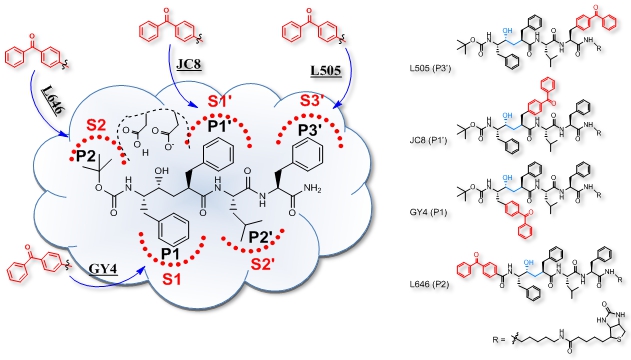
The photophore walking approach
The “photophore walking” approach has been developed to detect conformational changes in the γ-secretase active site. Requirements of photophore walking probes include: 1) that they directly interact with the active site, and 2) that photoactivatable groups are incorporated into different side chains along the probe, and therefore crosslink to different subpockets within the active site. Since the efficiency of photolabeling depends on the contact region and proximity to residues within the active site, conformational changes induced by GSMs that alter the orientation or distance between a subpocket and the photophore can lead to different cross-linking efficiencies. By exploiting the complementarity of more than one probe, one can examine changes within the active site of γ-secretase by comparing differences in labeling efficiency of each probe in the presence or absence of a modifier. This approach has been used to characterize different inhibitors and GSMs, as well as to investigate the conformational changes caused by PS1 FAD mutants.

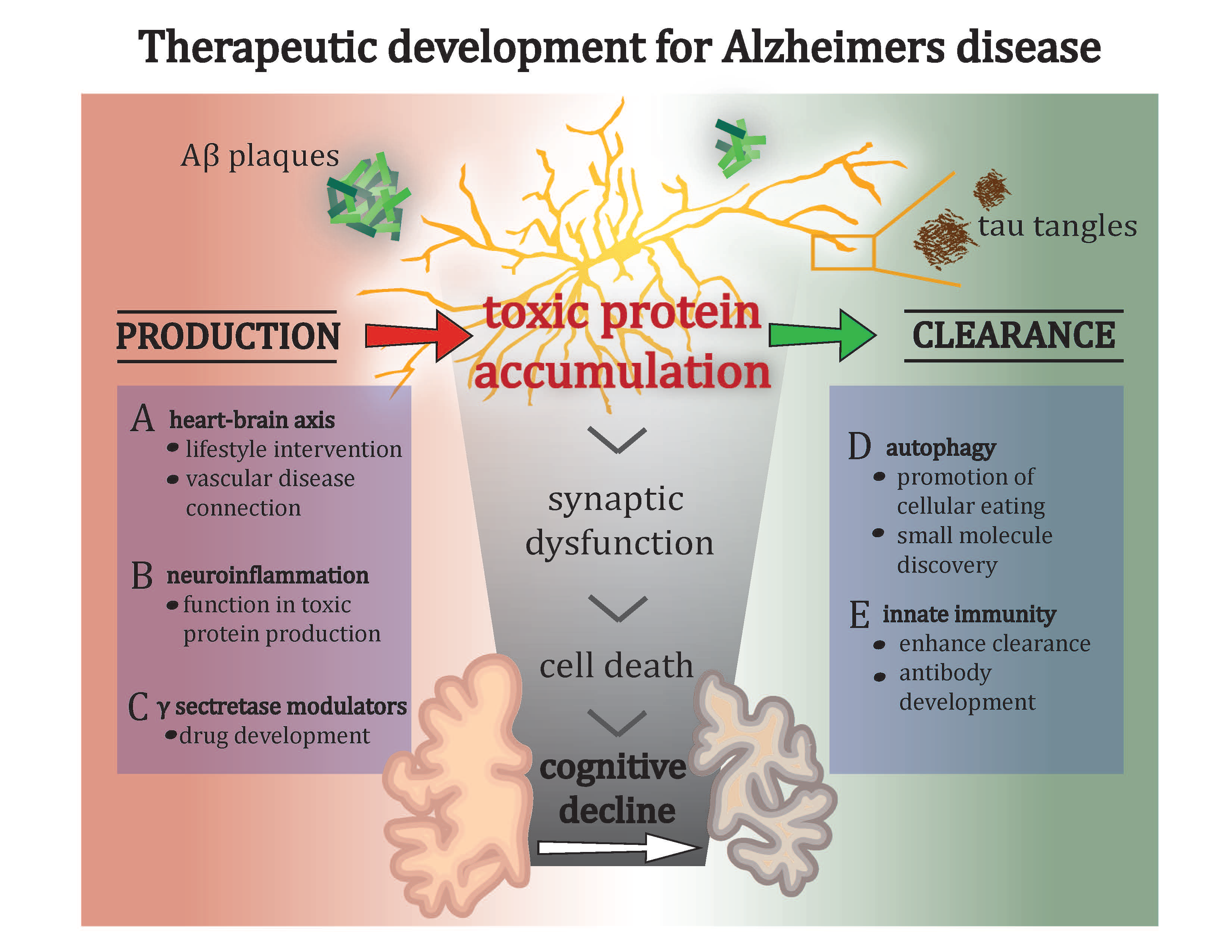
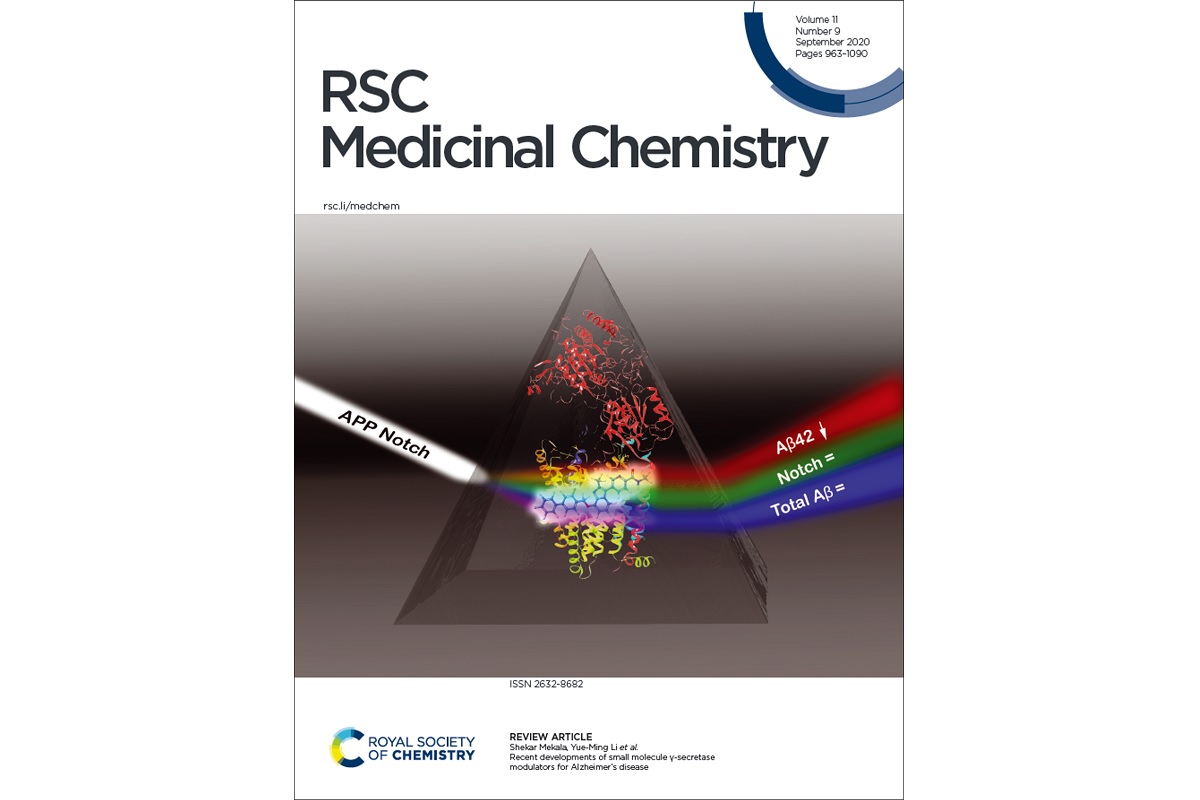
Recent developments of γ-secretase modulators for Alzheimer’s disease
Lab Links
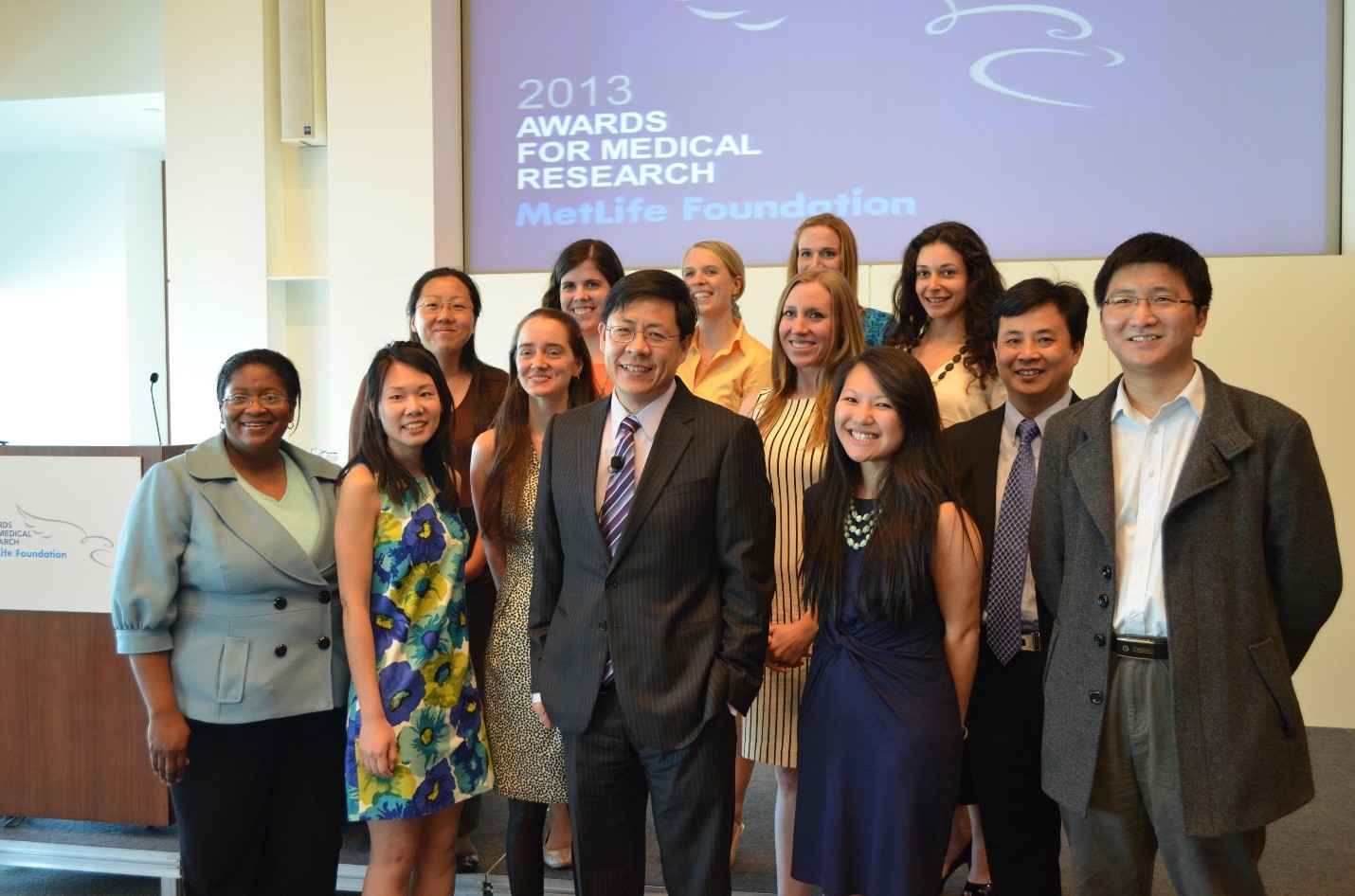
MetLife Foundation Award Video
The Dance of a Lifetime: Using Creativity and Perseverance in the Art of Science
Is Presenilin-1 really guilty of dismembering Alzheimer protein?
Alz Forum: Probe shines light on gamma-secretase inhibitors
Alz Forum: Yueming Li and Lennart Mucke win MetLife foundation award
Alz Forum: Reconstitution of gamma-secretase